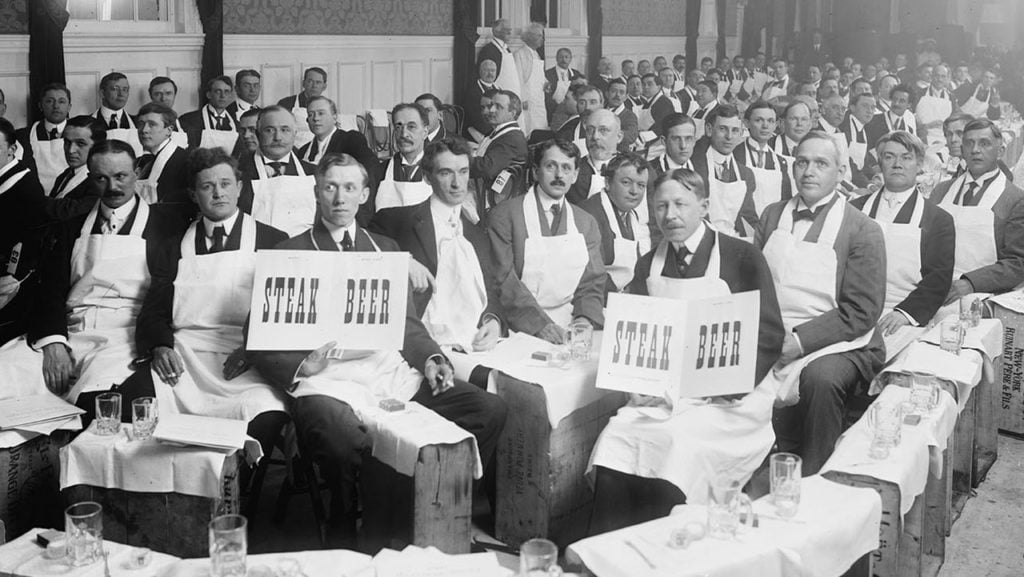Last Updated on March 1, 2022
Beefsteak banquets were once considered a guys-only event. But for generations, women have played a defining role in sustaining—and evolving—the feasting tradition.
My first beefsteak experience was in 2019. It included drinking whiskey, singing along to Beyoncé with a dozen or so feminists, and routinely wiping beef juice from my hands onto a paper table cloth. Cutlery, plates, and napkins are not permitted at this all-you-can-eat steak feast, an event with roots in the late 1800s. For many years, women weren’t permitted either.
Leah Quinn, a nurse practitioner and the evening’s hostess, wanted to change that. “Beefsteaks consisted of male debauchery, beer, and meat,” she explained. “I thought it’d be fun to reclaim this part of history that was initially men-only and make it about women, and allies of women.”
The Backstory on the Beefsteak
Originating among New York’s working class, beefsteaks were traditionally all-male events featuring beef short loin and beer, often thrown for political fundraising or celebrating community figureheads. Gents wore their second-best suits (prepared for grease stains) and butcher aprons. Sitting atop crates arranged in cellars or back rooms of taverns, they’d eat with their hands, guzzle pints, and grunt in praise while brass bands played.
Then the 19th Amendment, granting women’s suffrage, was certified. As The New Yorker columnist Joseph Mitchell described in his 1939 article “All You Can Hold for Five Bucks,” it “didn’t take women long to corrupt the beefsteak” and debase something “essentially masculine.”
Contrary to these lamentations, women have played—and continue to play—a defining role in keeping the beefsteak banquet alive and well for generations. They’ve become beefsteak honorees. Documented its history. Even evolved its dinner fare and festivities.
In gaining the right to vote in 1920, women presented a new demographic to win over during elections. Sponsors like New York’s Tammany Hall political machine, labor unions, and fraternal organizations began inviting them to beefsteaks to garner support. In accepting, women made clear their expectations for an elevated dining experience.

“The Women Push In”
Soon, the typical beef and beer menu expanded to include cocktails, salads, fruit cups, and open-face sandwiches. Hotels, restaurants, and apartment rooftops became the new venues. Silverware, napkins, and tablecloths appeared. Brass bands gave way to dance orchestras. Second-best suits were swapped for tuxedos. Traditionalists shook their heads at what Mitchell called “the frills introduced by women,” but there was no denying it: women’s influence had transformed the beefsteak from boorish free-for-all to lavish feast.
That’s not to say women didn’t enjoy any of the debauchery—they indulged in uncouth eating at common beefsteaks, too. At one point in his reporting, Joseph Mitchell described a woman urging her friend to eat more—“[D]on’t be bashful. Have a steak.”—despite the fact she’d just eaten six loin cuts. However, these rakish moments were few and far between in the 1930s. Prohibition had all but degenerated the New York beefsteak, forcing people to throw smaller—and less messy—dinners at home bars. The event wouldn’t return to its glory for another several years.
When the revival of New York beefsteaks swept the 1940s and 1950s, they were meticulously documented by culinary journalist Clementine Paddleford. Joining The New York Herald Tribune in 1936, she quickly established herself as America’s fearless regional-food reporter. Clementine was determined to cover the comeback of old-fashioned, men-only beefsteaks, even if it meant she was the only woman in the dining hall. Her accounts detailed everything from the cutting of a 31-pound steer hindquarter to the band’s entire setlist.
Clementine never wrote to appease the men in charge. In a 1946 beefsteak review, she didn’t hesitate to call a head chef “a fussy one picking a steak” or rib the beefsteak connoisseurs for arguing about serving the beef over toast or white bread. Her 1950 article profiling Wertheimer Market also acknowledged the beefsteak’s dated exclusivity and women’s insistence on being part of it. “Beer and meat on the menu: and rightfully only men on the guest list,” Clementine wrote cheekily, “but the women push in.”
A Tradition Evolves
Women continue to push in today with their own beefsteaks. Leanna Chroman and Jennifer Watterson are the Vice President of Culture and Learning and Director of Beverage and Special Events respectively at Harry & Izzy’s in Indianapolis. The first women to attain senior leadership at the restaurant (Watterson is also a General Manager), they oversee Harry & Izzy’s annual Ladies Beefsteak. What started as a gathering of 34 women several years ago has grown into a consistently sold-out event of more than 300, some traveling from Ohio, Michigan, Florida, even California.
Watterson loves the day’s camaraderie. “There’s this push for women to raise each other up more instead of bringing each other down. That’s what [Ladies Beefsteak] is about,” she explains. “It’s a chance to get away from everyday stress—as a mother, as a career-driven person, or both—and celebrate each other.”
Thrown to kick off March Madness, the Ladies Beefsteak combines traditional beefsteak elements with innovations from Leanna and Jennifer. Women receive their own aprons and pins marking each year they attend. They network with local vendors and businesses. They give staff real-time feedback on debut cocktails and menu items. Most importantly, they indulge in beef and beer while watching basketball.
“What I find so interesting about history, in general, is that when we try to make things inclusive of women, we think we have to make drastic changes,” says Leanna. “That in itself is not inclusive.”
As Jennifer and Leanna look to the future—and prepare for their first socially distanced Ladies Beefsteak this month—they remain hyper-focused on how to make Harry & Izzy’s more inclusive of women moving forward. “In Indiana, we generally have an uphill battle when it comes to gender equality,” says Leanna. “With events like Ladies Beefsteak, I think we’re helping pave the way.”
Carolyn Graceis a writer, podcast fanatic, and avid karaoke singer living in New York City. Her work has appeared in Culture Trip, Marie Claire, Parents, VegNews, Harness Magazine, and similar publications. A Philadelphia native, Carolyn studied journalism, American history, and French at the University of Pennsylvania, where she graduated magna cum laude in 2016.



